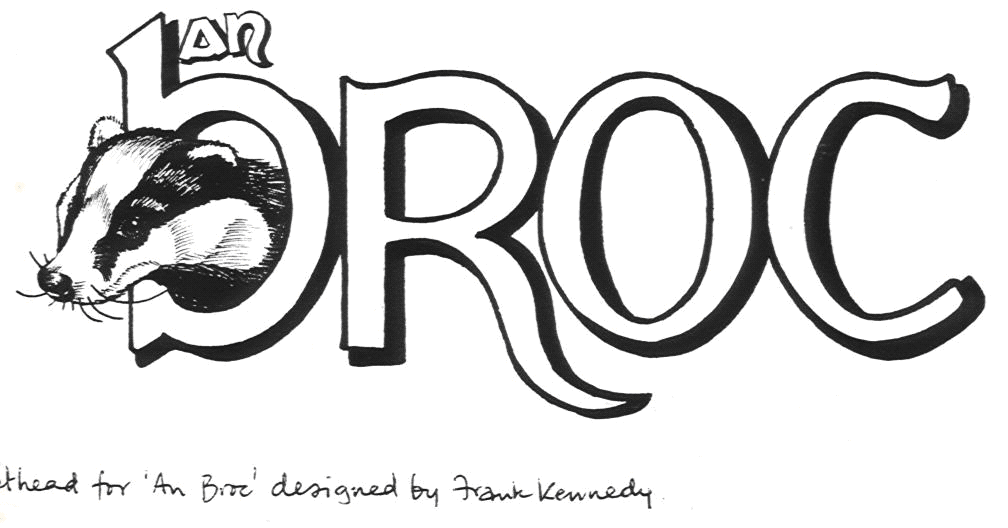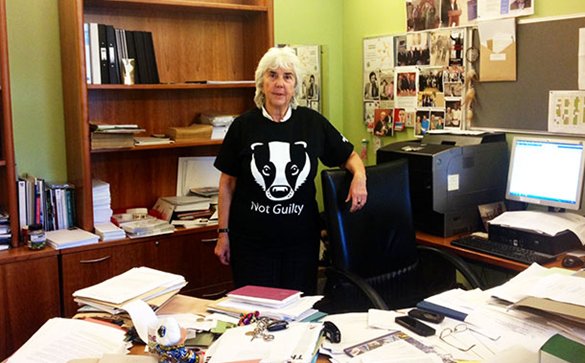
|
|
|
An Broc (The Badger) is the newsletter of Badgerwatch
(Ireland)
Spring 2015 Co-ordinator: Bernadette Barrett, 5, Tyrone Avenue, Lismore Lawn, Waterford. Irish Republic. E-mail Bernadettembarrett@gmail.com |
No let up on DAFM badger slaughter Figures acquired recently by Badgerwatch from the Department of Agriculture, Food and the Marine will reveal that, for the years 2013 and 2014 a grand total of 12,469 badgers met their untimely fate, trapped in Agriculture’s own weapon of mass destruction – the cruel multi strand wire snare. Small wonder 25,000 more body bags were ordered. It must have been an extremely busy time for DAFM’s army of badger killers. No threats of redundancies here. Business has never been better. Over the years, a number of landowners have found snares set on their land and badgers removed without their knowledge and certainly without permission. The number of incursions have been reported to Badgerwatch with such regularity that they cannot be dismissed as isolated incidents. Few members of the farming communities are familiar with the working timetable of trappers. Unfortunately, the damage is done before the landowner/herd-keeper becomes aware that badger - snaring has been carried out on the property. For the initial visit, trappers work on a two-week basis and will set snares for twelve nights out of 14. Licences cover a twelve month period which may be extended. Trappers will return periodically to check if there’s renewed badger activity at the sett(s). This being the case, snares will be set again. This will be repeated until the Department’s objective, total clearance of badgers has been achieved. According to a previous DAFM Minister, 6,000 snares are laid across Irish farmland nightly. If you as a landowner or herd- keeper discover uninvited trapping activity on your holdings remember you have rights. Badger trappers are obliged to show landowners/herd keepers the snaring licence. It is important to remember the licence does not confer automatic right of entry onto farm land and this is clearly stated at the bottom of the page. No person has the right to enter premises without your expressed permission. Any difficulties should be reported to your District Veterinary Inspector within a reasonable time. |
Deer culls next on DAFM’s list? (Indo Farming) Urgent Government action to cull 'out-of-control' wild deer has been demanded by the ICMSA, despite the Minister for Agriculture, Simon Coveney, claiming that badgers remain the key source of infection in TB blackspots. While ICMSA president, John Comer insisted that the wild deer herd had reached 150,000hd, and were "out of control" in Wicklow, Kerry and Clare, Minister Coveney said that TB levels in badgers were still higher in Wicklow. While ICMSA president, John Comer insisted that the wild deer herd had reached 150,000hd, and were "out of control" in Wicklow, Kerry and Clare, Minister Coveney said that TB levels in badgers were still higher in Wicklow. "My Department remains of the view that infection from wildlife, in particular badgers, remains a particular issue in the Wicklow area," he said in a Dail reply to Wicklow TD Andrew Doyle. "A recent study conducted in the Callary area detected a TB culture confirmation rate in badgers of over 26pc, which compares with a national rate of 13.3pc. The level of TB found in badgers was also considerably higher than that found in deer in that area, where 4.8pc of deer had visible lesions, with 5.5pc culturing positive for TB." Wicklow has the highest levels of TB in the country, with many parts experiencing twice the national average levels of infection. The Minister added that while the Department will continue to implement a badger removal programme in the county, responsibility for wild deer rested, under the Wildlife Acts, with the Minister for Arts, Heritage and the Gaeltacht and that a non-statutory Irish Deer Management forum had been established. Insufficient Over a quarter of all Bovine TB infected herds are now being identified through lesions found on carcasses of animals at the country's meat plants. |
Maureen O’Sullivan |
|
25,000 Badger body bags on order Maureen O’Sullivan
Posted date: September 26, 2014: He said “targeted badger removals will continue” until “a viable oral delivery method can be put in place” which was a most unfortunate answer because in the context of a badger cull we are talking about a most inhumane, cruel and barbaric way of dealing with bovine TB, when first, it has not been fully proven that the badger is totally responsible for the disease. There are doubts over some of the experiments that initially proved that was the case. Second, a reduction in TB in cattle can also be linked to improved husbandry and other factors, not especially through the badger cull. A badger cull is a particularly cruel way to deal with the problem. Illegal ways are in use to kill badgers. Such horrible practices, include putting slurry in badger setts, and throwing badger carcases onto the road to give the impression they have been killed in road accidents. That is what is happening to a badger population that we do not know is 100% responsible for bovine TB.I also asked the Minister to explain the urgency to kill thousands of an ecologically important species, namely, the badger? Recent reports have shown that injecting badgers significantly reduces the progress and severity of TB. Unlike culling, vaccination does not disrupt the badger’s social group and it provides immunity indirectly to unvaccinated badger cubs. Overall I am happy that the Minister made a guarantee that in the long term vaccination programs for badgers are the preferred option over the current practice of culling. There as still major concerns which I felt were not answered, such as the findings of various conservative agencies reports that the tests which cite badgers as the main cause of the spread of bovine TB amongst cattle is at the very least flawed. I still feel that the findings of these agencies should not be ignored and I will keep campaigning for the culling of these ecologically significant creatures to stop with immediate effect |
|
Badgers may shun cattle but it isn’t enough to save them being culled Margaret Donnelly
|
|
NI Badger Group Defends Badgers Against Bovine TB Claims March 24th 2015 The NI Badger Group has issued a statement on Bovine TB and culling and has attacked “scaremongering” about Bovine TB. |
|
|
|
Badgers are in the spotlight as the DARD TVR project unfolds. “We advocate, and are committed to supporting, an evidence-led strategy for addressing bovine TB in cattle. In that context we have a number of concerns, not least the continuing pressure from some individuals and groups to conduct a programme of badger culling in Northern Ireland similar to those carried out in SW England and the Irish Republic.
Peter Clarke added: “We also have concerns with regard to the large amount of scaremongering and misinformation about bovine TB that is peddled as fact in the public domain. Bovine TB is NOT a public health issue. Bovine TB is FALLING in Northern Ireland. In the last two years, herd incidence has fallen faster in Northern Ireland than in the Irish Republic where over 100,000 badgers have been culled. “Bovine TB is, understandably, an emotive topic. However, any strategy is only as effective as the quality of the information and data it is based on. Consequently, fact-based evidence and objectivity is paramount to establishing an effective bovine TB strategy in Northern Ireland.
|
Views expressed in An Broc may not necessarily be those of Badgerwatch (Ireland) |
Badgerwatch. 5, Tyrone Avenue, Waterford.. Ireland. 051-373876. barrettb@gofree.indigo.ie
Address 2 .......................................................…………………….. Address 3 .......................................................……………………..
Email...............………………......................................................... |